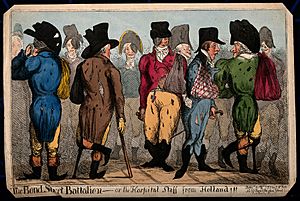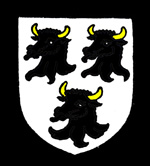Lumley Skeffington facts for kids
Sir Lumley St George Skeffington, 2nd Baronet (born March 23, 1771 – died November 10, 1850) was a British nobleman. He was known for being very interested in fashion, a bit like a trendsetter, and he was also a talented writer of plays.
Contents
A Life in the Spotlight
Sir Lumley Skeffington was born into an important family in 1771. He became the 2nd Baronet of his family in 1815. A "Baronet" is a special title, like a knight, that can be passed down in a family.
His Early Life and Love for Drama
Lumley went to Newcome's School in Hackney. There, he discovered his passion for writing and performing plays. This love for drama would become a big part of his life.
Writing for the Stage
Sir Lumley wrote several plays that were performed in famous London theaters.
Early Plays
In May 1802, his five-act comedy called The Word of Honour was shown at Covent Garden theater. The next year, another play, The High Road to Marriage, was performed at Drury Lane. Both of these plays were quite popular.
A Big Success
His most famous play was a "grand legendary melodrama" called The Sleeping Beauty. It was performed at Drury Lane in May 1805. This play was a big achievement for him.
Other Works
He continued to write more plays, including:
- Maids and Bachelors (1806)
- The Mysterious Bride (1808)
- Ethelinde (an opera around 1810)
- Lose No Time (a comedy)
Most of his plays were not printed as books, so we only know about them from their performances.
A Fashion Icon
Sir Lumley was also famous for his amazing sense of style. He was known as a "dandy," which meant he paid a lot of attention to his clothes and appearance. He was so good at fashion that even the Prince Regent (who later became King George IV) asked him for advice on what to wear!
Skeffington Brown
He even invented a new color called "Skeffington brown." This shows how much influence he had on fashion during his time. People often made fun of his fashion sense in cartoons and writings, but he was still a very well-known figure.
Family and Legacy
Sir Lumley Skeffington was the only son of William Charles Farrell-Skeffington, the 1st Baronet. When his father passed away, Lumley inherited the Baronet title. However, he never married or had children. Because of this, when he died on November 10, 1850, the title of Baronet ended with him.



